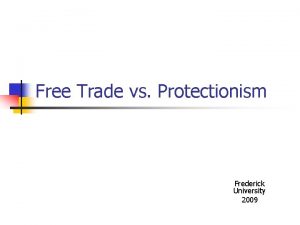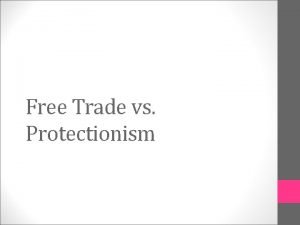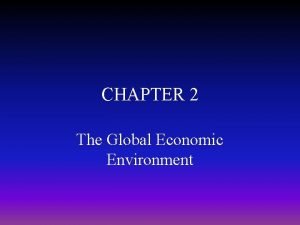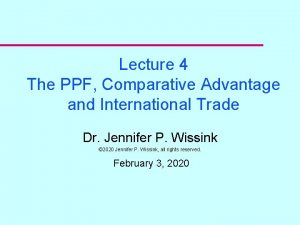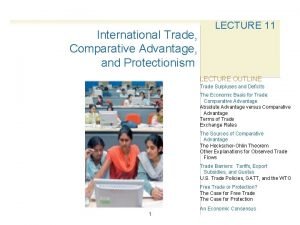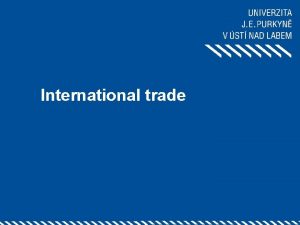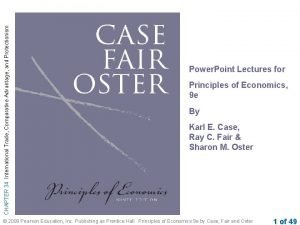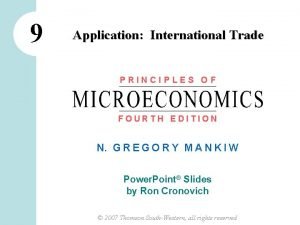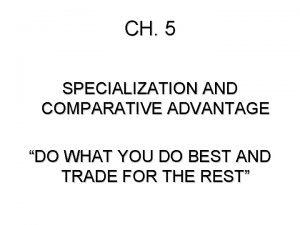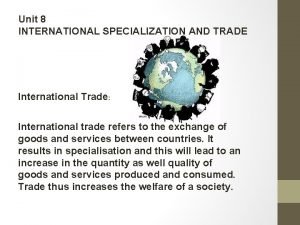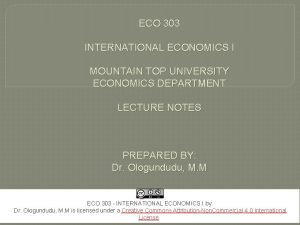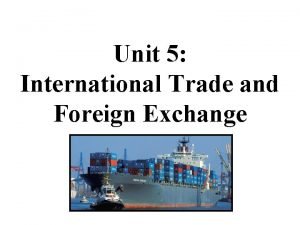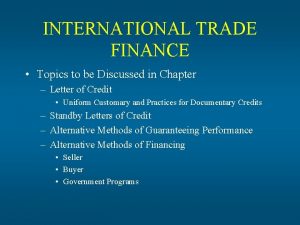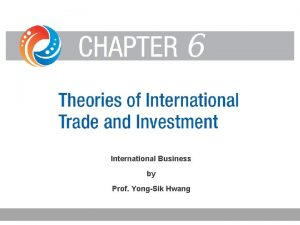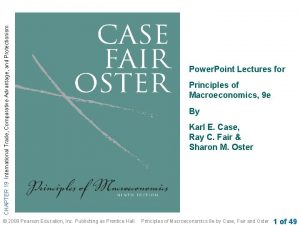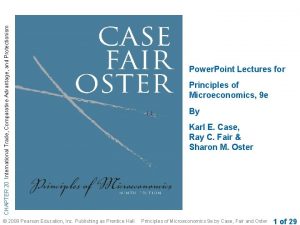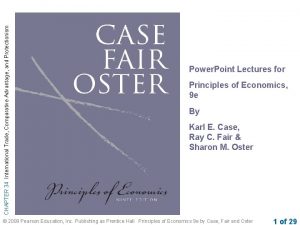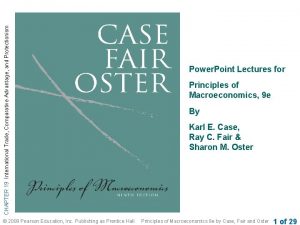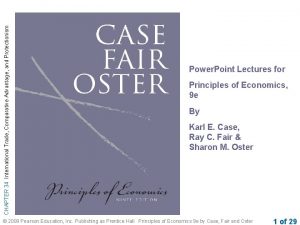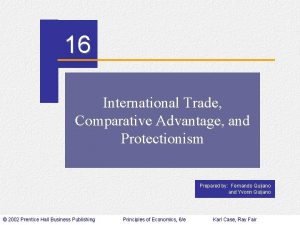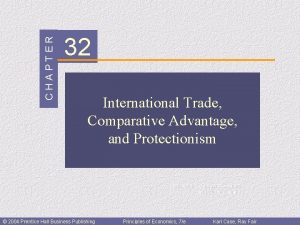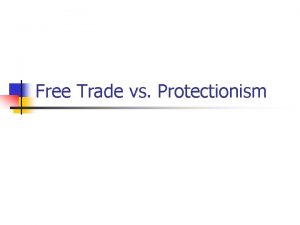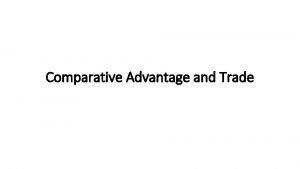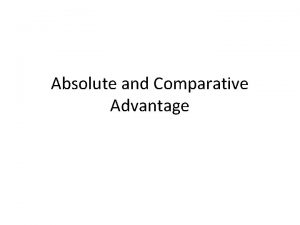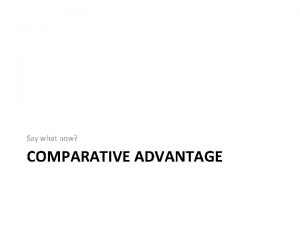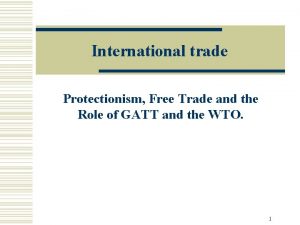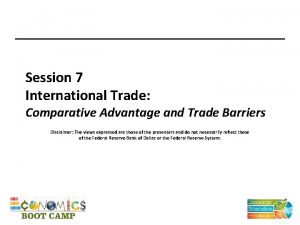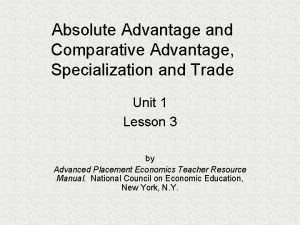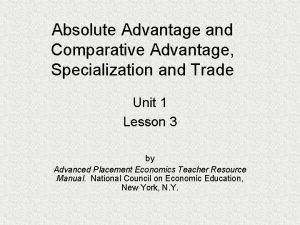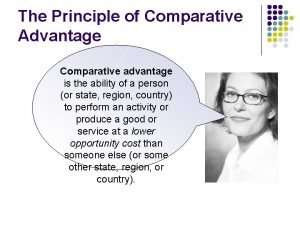CHAPTER 20 International Trade Comparative Advantage and Protectionism

























- Slides: 25

CHAPTER 20 International Trade, Comparative Advantage, and Protectionism Prepared by: Fernando Quijano and Yvonn Quijano © 2004 Prentice Hall Business Publishing Principles of Economics, 7/e Karl Case, Ray Fair

C H A P T E R 20: International Trade, Comparative Advantage, and Protectionism International Trade • All economies, regardless of their size, depend to some extent on other economies and are affected by events outside their borders. © 2004 Prentice Hall Business Publishing Principles of Economics, 7/e Karl Case, Ray Fair 2 of 47

C H A P T E R 20: International Trade, Comparative Advantage, and Protectionism International Trade • The “internationalization” or “globalization” of most economies has occurred in the private and public sectors, in input and output markets, and in business firms and households. © 2004 Prentice Hall Business Publishing Principles of Economics, 7/e Karl Case, Ray Fair 3 of 47

C H A P T E R 20: International Trade, Comparative Advantage, and Protectionism Trade Surpluses and Deficits • When a country exports more than it imports, it runs a trade surplus. • A trade deficit is the situation when a country imports more than it exports. © 2004 Prentice Hall Business Publishing Principles of Economics, 7/e Karl Case, Ray Fair 4 of 47

C H A P T E R 20: International Trade, Comparative Advantage, and Protectionism Trade Surpluses and Deficits U. S. Balance of Trade (Exports Minus Imports), 1929– 2002 (Billions of Dollars) EXPORTS MINUS IMPORTS 1929 1933 1945 1955 1960 1965 1970 1975 1976 1977 1978 1979 1980 1981 1982 1983 1984 1985 EXPORTS MINUS IMPORTS 1986 1987 1988 1989 1990 1991 1992 1993 1994 1995 1996 1997 1998 1999 2000 2001 2002 + 0. 4 + 0. 1 – 0. 9 + 0. 4 + 2. 4 + 3. 9 + 1. 2 + 13. 6 – 2. 3 – 23. 7 – 26. 1 – 24. 0 – 14. 9 – 15. 0 – 20. 5 – 51. 7 – 102. 0 – 114. 2 – 131. 9 – 142. 3 – 106. 3 – 80. 7 – 71. 4 – 20. 7 – 27. 9 – 60. 5 – 87. 1 – 84. 3 – 89. 0 – 89. 3 – 151. 7 – 249. 9 – 365. 5 – 348. 9 – 423. 6 Source: U. S. Department of Commerce, Bureau of Economic Analysis. © 2004 Prentice Hall Business Publishing Principles of Economics, 7/e Karl Case, Ray Fair 5 of 47

C H A P T E R 20: International Trade, Comparative Advantage, and Protectionism Define These Terms • Define each of the following terms in your notes. Use your phones or chromebooks to find the answers if needed. We will review them once you have defined them. © 2004 Prentice Hall Business Publishing Principles of Economics, 7/e Karl Case, Ray Fair

C H A P T E R 20: International Trade, Comparative Advantage, and Protectionism • Comparative Advantage, Absolute Advantage, Terms of Trade, Exchange Rate, Tariff, Quota, General Agreement on Tariffs and Trade (GATT), European Union, North American Free Trade Agreement (NAFTA), Infant Industry. © 2004 Prentice Hall Business Publishing Principles of Economics, 7/e Karl Case, Ray Fair

C H A P T E R 20: International Trade, Comparative Advantage, and Protectionism The Economic Basis for Trade: Comparative Advantage • Comparative Advantage: When one nation is better in a particular industry or resource production than another. © 2004 Prentice Hall Business Publishing Principles of Economics, 7/e Karl Case, Ray Fair 8 of 47

C H A P T E R 20: International Trade, Comparative Advantage, and Protectionism Absolute Advantage versus Comparative Advantage • A country enjoys an absolute advantage over another country in the production of a product when it uses fewer resources to produce that product than the other country does. © 2004 Prentice Hall Business Publishing Principles of Economics, 7/e Karl Case, Ray Fair 9 of 47

C H A P T E R 20: International Trade, Comparative Advantage, and Protectionism Absolute Advantage versus Comparative Advantage • A country enjoys a comparative advantage in the production of a good when that good can be produced at a lower cost in terms of other goods. © 2004 Prentice Hall Business Publishing Principles of Economics, 7/e Karl Case, Ray Fair 10 of 47

C H A P T E R 20: International Trade, Comparative Advantage, and Protectionism Gains from Comparative Advantage • Even if a country had a considerable absolute advantage in the production of both goods, it can be argued that specialization and trade are still mutually beneficial. © 2004 Prentice Hall Business Publishing Principles of Economics, 7/e Karl Case, Ray Fair 11 of 47

C H A P T E R 20: International Trade, Comparative Advantage, and Protectionism Gains from Comparative Advantage • When countries specialize in producing the goods in which they have a comparative advantage, they maximize their combined output and allocate their resources more efficiently. © 2004 Prentice Hall Business Publishing Principles of Economics, 7/e Karl Case, Ray Fair 12 of 47

C H A P T E R 20: International Trade, Comparative Advantage, and Protectionism Terms of Trade • The ratio at which a country can trade domestic products for imported products is the terms of trade. • The terms of trade determine how the gains from trade are distributed among trading partners. © 2004 Prentice Hall Business Publishing Principles of Economics, 7/e Karl Case, Ray Fair 13 of 47

C H A P T E R 20: International Trade, Comparative Advantage, and Protectionism Exchange Rates • When trade is free—unimpeded by government-instituted barriers— patterns of trade and trade flows result from the independent decisions of thousands of importers and exporters and millions of private households and firms. • To understand these patterns we must learn about exchange rates. © 2004 Prentice Hall Business Publishing Principles of Economics, 7/e Karl Case, Ray Fair 14 of 47

C H A P T E R 20: International Trade, Comparative Advantage, and Protectionism Exchange Rates • An exchange rate is the ratio at which two currencies are traded, or the price of one currency in terms of another. • For any pair of countries, there is a range of exchange rates that can lead automatically to both countries realizing the gains from specialization and comparative advantage. © 2004 Prentice Hall Business Publishing Principles of Economics, 7/e Karl Case, Ray Fair 15 of 47

C H A P T E R 20: International Trade, Comparative Advantage, and Protectionism Trade Barriers: Tariffs, Export Subsidies, and Quotas • Protection is the practice of shielding a sector of the economy from foreign competition. • A tariff is a tax on imports. • A quota is a limit on the quantity of imports. © 2004 Prentice Hall Business Publishing Principles of Economics, 7/e Karl Case, Ray Fair 16 of 47

C H A P T E R 20: International Trade, Comparative Advantage, and Protectionism Trade Barriers: Tariffs, Export Subsidies, and Quotas • Export subsidies are government payments made to domestic firms to encourage exports. • Dumping refers to a firm or industry that sells products on the world market at prices below the cost of production. © 2004 Prentice Hall Business Publishing Principles of Economics, 7/e Karl Case, Ray Fair 17 of 47

C H A P T E R 20: International Trade, Comparative Advantage, and Protectionism U. S. Trade Policies and GATT • The General Agreement on Tariffs and Trade (GATT) is an international agreement singed by the United States and 22 other countries in 1947 to promote the liberalization of foreign trade. © 2004 Prentice Hall Business Publishing Principles of Economics, 7/e Karl Case, Ray Fair 18 of 47

C H A P T E R 20: International Trade, Comparative Advantage, and Protectionism Economic Integration • Economic integration occurs when two or more nations join to form a free-trade zone. • The European Union (EU) and the North American Free-Trade Agreement NAFTA are examples of economic integration. © 2004 Prentice Hall Business Publishing Principles of Economics, 7/e Karl Case, Ray Fair 19 of 47

C H A P T E R 20: International Trade, Comparative Advantage, and Protectionism Economic Integration • The European Union (EU) is the European trading bloc composed of Austria, Belgium, Denmark, Finland, France, Germany, Greece, Ireland, Italy, Luxembourg, the Netherlands, Portugal, Spain, Sweden, and the United Kingdom. © 2004 Prentice Hall Business Publishing Principles of Economics, 7/e Karl Case, Ray Fair 20 of 47

C H A P T E R 20: International Trade, Comparative Advantage, and Protectionism Economic Integration • The U. S. -Canadian Free-Trade Agreement is an agreement in which the United States and Canada agreed to eliminate all barriers to trade between the two countries by 1988. © 2004 Prentice Hall Business Publishing Principles of Economics, 7/e Karl Case, Ray Fair 21 of 47

C H A P T E R 20: International Trade, Comparative Advantage, and Protectionism Economic Integration • The North American Free-Trade Agreement (NAFTA) is an agreement signed by the United States, Mexico, and Canada in which the three countries agreed to establish all of North America as a free-trade zone. © 2004 Prentice Hall Business Publishing Principles of Economics, 7/e Karl Case, Ray Fair 22 of 47

C H A P T E R 20: International Trade, Comparative Advantage, and Protectionism The Case for Free Trade • The case for free trade is based on theory of comparative advantage. When countries specialize and trade based on comparative advantage, consumers pay less and consume more, and resources are used more efficiently. • When tariffs and quotas are imposed, some of the gains from trade are lost. © 2004 Prentice Hall Business Publishing Principles of Economics, 7/e Karl Case, Ray Fair 23 of 47

C H A P T E R 20: International Trade, Comparative Advantage, and Protectionism The Case for Protection • Protection saves jobs • Some countries engage in unfair trade practices • Cheap foreign labor makes competition unfair • Protection safeguards national security • Protection discourages dependency • Protection safeguards infant industries © 2004 Prentice Hall Business Publishing Principles of Economics, 7/e Karl Case, Ray Fair 24 of 47

C H A P T E R 20: International Trade, Comparative Advantage, and Protectionism The Case for Protection • An infant industry is a young industry that may need temporary protection from competition from the established industries of other countries to develop an acquired comparative advantage. © 2004 Prentice Hall Business Publishing Principles of Economics, 7/e Karl Case, Ray Fair 25 of 47
 Protectionism in trade
Protectionism in trade Free trade vs protectionism
Free trade vs protectionism Free trade vs protectionism
Free trade vs protectionism Protectionism pros and cons
Protectionism pros and cons Ppf
Ppf Comparative advantage
Comparative advantage Benefits of protectionism economics
Benefits of protectionism economics Advantages of protectionism
Advantages of protectionism Chapter 6 - theories of international trade and investment
Chapter 6 - theories of international trade and investment Chapter 9 application: international trade answers
Chapter 9 application: international trade answers Actual mechanical advantage vs ideal mechanical advantage
Actual mechanical advantage vs ideal mechanical advantage Trade diversion and trade creation
Trade diversion and trade creation Umich
Umich Which is the most enduring free trade area in the world?
Which is the most enduring free trade area in the world? Trade diversion and trade creation
Trade diversion and trade creation Tramp liner
Tramp liner Specialization and comparative advantage
Specialization and comparative advantage When discussing comparative and absolute advantage
When discussing comparative and absolute advantage Specialization in international trade
Specialization in international trade Certificate in international trade and finance citf
Certificate in international trade and finance citf Kravis theory of international trade
Kravis theory of international trade Unit 5 international trade
Unit 5 international trade International trade and finance topics
International trade and finance topics Theories of international trade and investment
Theories of international trade and investment The trade in the trade-to-gdp ratio
The trade in the trade-to-gdp ratio Fair trade not free trade
Fair trade not free trade
